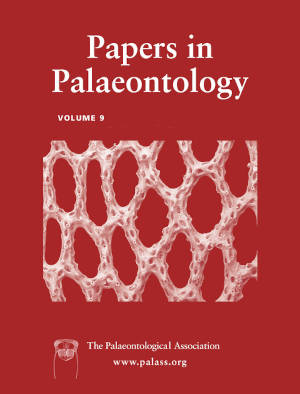Article: Macroflora from Lower Jurassic (Pliensbachian) of Hicks Creek, southern Talkeetna Mountains, south-central Alaska
Publication: Papers in Palaeontology
Volume:
9
Part:
6
Publication Date:
2023
Article number:
e1541
Author(s):
Maria Barbacka, Artur Górecki, Christian Pott, Jadwiga Ziaja, Robert B. Blodgett, Curvin Metzler, Andrew H. Caruthers, Geethanalje Edirisooriya, and Grzegorz Pacyna
DOI:
10.1002/spp2.1541
Abstract
Abstract A recently discovered Early Jurassic locality at Hicks Creek, Talkeetna Mountains, Alaska, yielded a macrofossil plant assemblage comprising predominantly bennettitaleans and ferns, accompanied by horsetails, seed ferns, cycads and conifers. Single species from different plant groups dominate the assemblage (e.g. Cladophlebis alata, Otozamites pterophylloides; less frequent Rhaphidopteris sp. and Pagiophyllum falcatum; sporadic Thallites sp., Klukia sp., Todites williamsonii, Coniopteris bella, Sagenopteris sp., Zamites sp., Nilssoniopteris pristis, Pseudoctenis sp., Eretmophyllum sp. and Elatides sp.). We also encountered a new foliage of cycadophyte type, Hanophyllum varioserratum gen. et sp. nov. Hicks Creek is one of four Alaskan areas with fossil Mesozoic plants that have been investigated. Along with rocks of Puale Bay and the East Fork of Boulder Creek exposures, this locality is of Early Jurassic age, while Cape Lisburne is Early Cretaceous (Albian). Based on a comparison of the floral composition of Hicks Creek with some other localities (Alaska and beyond), environmental conditions for the Peninsular terrane are inferred. Floristic differences between localities are explained by the varied topography, interpreted as disturbed coastal–lagoonal or as undisturbed, moist and warm inland. Some taxa (Todites williamsonii, Coniopteris bella, Nilssoniopteris pristis, Otozamites tenuatus, O. mimetes, Brachyphyllum crucis) common to the Alaska Peninsula and Middle Jurassic of Yorkshire may suggest a possible pathway of plant migration during the movement of the Peninsular terrane. The occurrence of Cladophlebis alata in the Lower Jurassic of south-central Alaska and the Lower Cretaceous of northwestern Alaska may also shed light on the posited spread of this species.
